Herding
By Fi Cameron
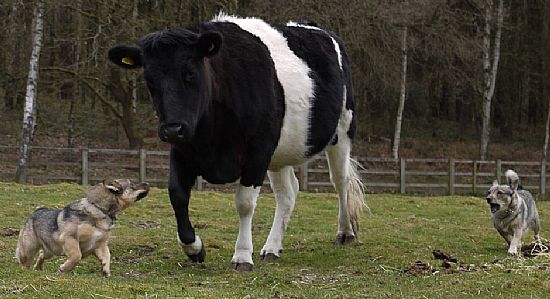
Since 2009 I have been exploring the potential of our 6 Vallhunds as working herding dogs, particularly in ‘real life’ practical situations that can occur in a Smallholding.
The following is based purely on my experience and is merely my opinion. There is no one way to train your Vallhund for herding livestock, it depends on the relationship you have with your dogs, on the livestock, and what exactly you want to use them for. We feel the only way to preserve the practical ability of the breed to herd livestock is by working in ‘real’ situations. As occasional breeders we aim for sound construction and the Breed Standard but also for a useful herding ability and hope that this article may encourage some others to explore herding.
I have organised 4 ‘Herding Days’ over that time at different venues to enable owners of around 25 Vallhunds to explore their herding instincts with sheep. In 2018/2019 three of our Vallhunds became the first in the UK to gain AHBA Herding Titles (JHD & HTAD1). But what they really enjoy best is doing ‘‘jobs’’ at home with our 2 Heifers and 16 sheep.

Firstly a few definitions:
What is ’Herding’? For me Herding is the ‘’Controlled Movement of Livestock’’. Vallhunds (the word means ’Herding Dog’) were primarily used as ’general purpose farm dogs’ in Sweden, particularly useful with cattle. All of ours are also good at ratting. Nowadays in the UK the word ’Herding’ is associated largely with the image of a Border Collie and it is often forgotten that there are many European breeds who also ‘control’ livestock in very different ways i.e. the ‘loose eyed or upright’ breeds. Of course, Vallhunds will never be the stuff of Moorland Gathers or indeed Cattle Ranches, but from my experience, they can be of serious practical use in a Smallholding.
Vallhunds obediently ‘stopping’ and then ‘walking on’ behind very tame sheep who just follow behind the handler without the dog engaging with the stock (as is sometimes seen in videos) is also not herding in my opinion. To me this is a ‘dumbing down’ of the very useful instinct that they have. Sheep and cattle ’in the real world’ very soon realise that the dog really does not mean business, which can be dangerous for the dog.
Similarly, when first exposed to sheep or cattle, a Vallhund will often move them ‘over enthusiastically’, and whilst this may be showing an instinct, it is also not strictly ‘herding’, however good it looks in a photo. True control of livestock takes a lot of time-consuming training on top of that instinct, and with Vallhunds there is a very delicate balance between the two.
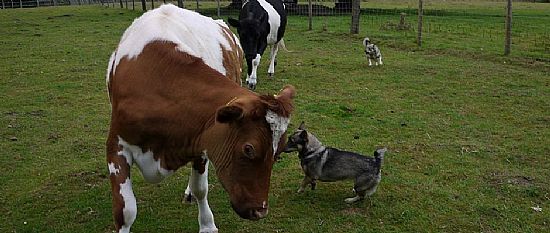
Some examples of their use for me:
- 16 Shetland sheep in a 4-acre field, one is limping…. I could try to bribe them into a pen with food, but you can guarantee (a sheep thing!) that the lame one won’t go in to be caught, plus the expense of food. I can send 8 year old Tilly Vallhund to fetch the flock to me, she will keep them tight to me as she ‘’wears’’ back and forth behind them until I can grab the said sheep, turn it on its back and sort it out….meanwhile Tilly will back off and dig up some mole hills without hassling the sheep until I am ready again.
- If I want our 2 Shetland heifers to go into the barn to treat them to protect against flies in the summer…. yes, I could bribe them with corn…. expensive again plus they get a bit over enthusiastic! Or I can put a brace of Vallhunds in with them and they will take them into the barn for me… job done!

More Cattle than Sheep Herders:
Vallhunds are undoubtedly naturally more cattle herders than sheep herders. Their basic drive is to ‘make it move’! With cattle this involves barking and accelerating towards the cow before stopping suddenly at the last minute to initiate movement, sometimes jumping up at the muzzle of the cow. They then combine tucking in behind their heels, nipping at the cows pasterns (usually whichever pastern is on the ground and therefore weight bearing and ’wearing’ back and forth to keep the movement going, often moving towards the shoulder of the cow so as to be within its visual field. Whilst mine will face the heads of cattle and get them to move away from them by standing their ground, none of mine will ‘grip’ in the true sense of the word, on our smallholding they have quite a spirited but amicable relationship with the cows. I have never seen mine ‘flatten’ themselves under the kicking heels of cows as is often quoted with Vallhunds…. But they will keep low if focussing on a pastern to nip. Otherwise they either learn the hard way or instinctively know that a cow’s kick hurts and best to keep out of range. My Shetland Heifers are very laid back and take some shifting, my dogs learnt from a recent Herding Clinic that some cows really don’t need such a ‘vocal’ approach.
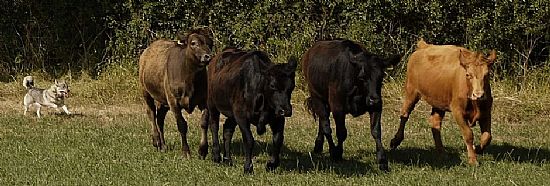
Sheep Herding:
Sheep of course require a different approach, and it is possible that only some ‘lines’ of Vallhunds have a strong enough ‘drive’ to take the training necessary to modify their cattle herding instincts without ‘switching off’ altogether. In my experience it is only when they are given experience at least 3 times a week that they really progress. Impossible to give detail in a short article, but I avoid starting them in a round pen and allow them a free rein with dog broke sheep in a large field until they are around a year old. I am very protective of my sheep and they have never come to harm from my Vallhunds. That way the dogs learn what works, what doesn’t, and develop confidence, the barking stops, and they realise that it takes very little to make sheep move.

All of ours have needed to learn to ’rate’ sheep: as a heeler their instinctive ‘power’ is sudden speed and keeping close…. if you over correct that without first developing confidence you effectively stop them herding. Rather than ‘pushing them out’ I find working them with large flocks teaches them ‘rate’, alternatively teaching a ‘stop’ off sheep, and then getting the far side of the flock from the dog and allowing a steady ’walk up’ also works. Back in 2009 I worked Loki & Megan at an Agricultural College with both on a long line, merely walking behind the sheep with the line only controlling them if they rushed at the sheep….Loki learnt a lot of ‘rate’ from this, eventually taking 70 sheep through gateways to me, but I think he was an exceptional Vallhund in his Herding ability. A lot is learnt by just walking around a big field with your Vallhund holding the flock to you, changing direction, and some Vallhunds will ‘balance’ the sheep to you.
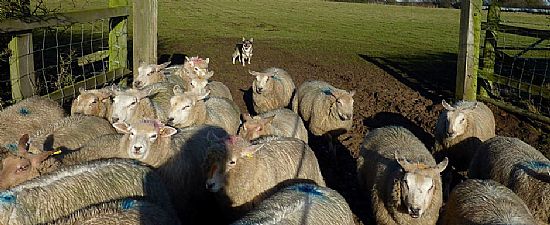
Instincts Bred In:
We have been fortunate in breeding a line of Vallhunds that seem to have an instinct for ‘covering’ sheep to the outside, thus keeping the sheep together. Often tapping a stock stick on the ground (opening the gate) will instinctively produce a flank in the opposite direction. Outruns along a fence line are also possible once the dog knows the benefit.
Herding is all about the livestock so as a handler you need to get to know the stock that you want your dog to herd, whether it be cattle, sheep or goats. You need to source access to livestock if you don’t have your own, and always be kind to the livestock that you work. Herding livestock can be hazardous for both you and your Vallhund. Two of our Vallhunds have received kicks from cows (shook themselves off and carried on) and stroppy old ewes can come from nowhere to attempt to headbutt a dog, plus there is that moment when you take your eye off the sheep and land on your backside….
I have kept in touch with 2 trainers over the past 10 years who have been able to embrace the value of Vallhunds in the control of livestock. Always good to discuss and view them training before embarking on using their methods. Vallhunds are a stubborn Spitz breed – quite ‘soft’ compared to some BCs, mine will only work for me. If you establish confidence and a bond with them, they are the best little ‘farmers companions. If your trainer is harsh with them, your Vallhund will tell them to ‘sod off!’ What works with Border Collies (we have a young BC ourselves) will not necessarily work with a Vallhund, (and there is of course not one ‘formula’ with a BC)
In my experience it is only when you have your own livestock and ’work’ becomes about caring for and managing your livestock rather than ’training’ your Vallhund that you see their true worth.
This article is inspired by Loki – sadly no longer with us. People often remark that a Border Collie ‘needs’ to herd…. Loki taught me that some Vallhunds also ‘need’ to herd. Working livestock gave Loki a job and a purpose, and as a result he found his place in the world.
Finally: if you take ’Herding’ out of a Vallhund…. do you really have a Vallhund?
Happy Herding!
Below: Ursa at 13 weeks old, meeting cows for the first time…..
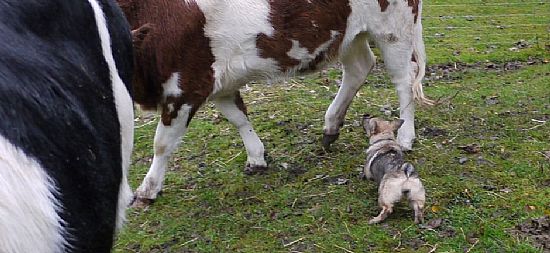
Fiona Cameron and Tim Woods: Bowkol Swedish Vallhunds. (May 2020)
Below is a list of our Vallhunds Kennel Names. Herding Instinct is inherited and therefore their Ancestry is important.
Loki: Starvon Off the Cuff for Bowkol. (27/10/05-30/04/2017)
Megan: Castleavery Gold Gaiety for Bowkol (03/10/2007- 26/05/.2018)
Tilly: Starvon Valkyrja Mist for Bowkol (DOB 03/12/2010)
Freki: Bowkol Dragon Dancer (DOB 25/09/2013)
Teja: Bowkol Am Buachaille (DOB 03/05/2016)
Ursa: Bowkol Akasha Fire (DOB 06/08/2019)
Below are Links to some of our Herding You Tube Videos that you may find interesting:
Tilly & Teja Herding Heifers March 2019
Loki Herding 60 sheep March 2011
Videos of Herding
Video courtesy of Lynn Pallatina
Videos courtesy of Fi Cameron